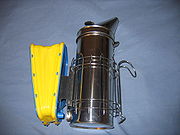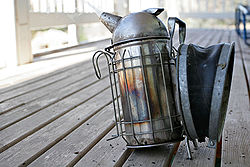
Bee smoker
Encyclopedia

Beekeeping
Beekeeping is the maintenance of honey bee colonies, commonly in hives, by humans. A beekeeper keeps bees in order to collect honey and other products of the hive , to pollinate crops, or to produce bees for sale to other beekeepers...
to calm honey bee
Honey bee
Honey bees are a subset of bees in the genus Apis, primarily distinguished by the production and storage of honey and the construction of perennial, colonial nests out of wax. Honey bees are the only extant members of the tribe Apini, all in the genus Apis...
s. It is designed to generate smoke from the smouldering of various fuels, hence the name.
Action and usage

Pheromone
A pheromone is a secreted or excreted chemical factor that triggers a social response in members of the same species. Pheromones are chemicals capable of acting outside the body of the secreting individual to impact the behavior of the receiving individual...
s (which include various chemicals, e.g., isopentyl acetate) that are released by guard bees or bees that are injured during a beekeeper's inspection. The smoke creates an opportunity for the beekeeper to open the beehive
Beehive
A beehive is a structure in which bees live and raise their young.Beehive may also refer to:Buildings and locations:* Bee Hive, Alabama, a neighborhood in Alabama* Beehive , a wing of the New Zealand Parliament Buildings...
and work while the colony's defensive response is interrupted. In addition, smoke initiates a feeding response in anticipation of possible hive abandonment due to fire. When a bee consumes honey the bee's abdomen distends, making it difficult to make the necessary flexes to sting. (The latter has always been the primary explanation of the smoker's effect, since this behavior of bees is easily observable.)
Smoke is of limited use with a swarm, partly because swarms have no honey stores to feed on. It is usually not needed, either, since swarms tend to be less defensive as they have no home to defend, and a fresh swarm will have fed well at the hive it left behind.
Design and operation of a traditional smoker

Bellows
A bellows is a device for delivering pressurized air in a controlled quantity to a controlled location.Basically, a bellows is a deformable container which has an outlet nozzle. When the volume of the bellows is decreased, the air escapes through the outlet...
as originally employed by smith
Smith (metalwork)
A metalsmith, often shortened to smith, is a person involved in making metal objects. In contemporary use a metalsmith is a person who uses metal as a material, uses traditional metalsmithing techniques , whose work thematically relates to the practice or history of the practice, or who engages in...
s or other workers.
Moses Quinby
Moses Quinby
Moses Quinby was one of the first commercial beekeepers in the United States, a native of St. Johnsville, New York.Quinby established his business in his early 20s and expanded it to own about 1,200 hives in the Mohawk Valley, New York....
, the first commercial beekeeper in the United States, is credited with the invention of the modern single-handheld smoker (1875), with a bellows
Bellows
A bellows is a device for delivering pressurized air in a controlled quantity to a controlled location.Basically, a bellows is a deformable container which has an outlet nozzle. When the volume of the bellows is decreased, the air escapes through the outlet...
attached to a tin burner. Encyclopædia Britannica
Encyclopædia Britannica
The Encyclopædia Britannica , published by Encyclopædia Britannica, Inc., is a general knowledge English-language encyclopaedia that is available in print, as a DVD, and on the Internet. It is written and continuously updated by about 100 full-time editors and more than 4,000 expert...
mentions T. F. Bingham of Farwell, Michigan
Farwell, Michigan
Farwell is a village in Clare County in the U.S. state of Michigan. The population was 855 at the 2000 census.-Geography:According to the United States Census Bureau, the village has a total area of , of which, of it is land and of it is water....
, USA as the inventor of the smoker "most used in America and in the United Kingdom." His design was based on that of Quinby.
Many types of fuel can be used in a smoker as long as they are natural and uncontaminated with harmful substances. These fuels include hessian, burlap, pine needles, corrugated cardboard, paper egg cartons, and rotten or punky wood. Some beekeeping supply sources also sell commercial fuels like pulped paper and compressed cotton.
The fuel in the smoker's burner smoulders slowly because there is only a small amount of oxygen inside, until a squeeze of the bellows provides a blast of fresh air. In this way the fuel is used more sparingly than in an open pan, and one load of fuel may last for several hours, or even days (if it is extinguished and rekindled again later). To calm the bees, the smoke must not be hot.
There is a great variety of modifications to the basic design. As the burner can get very hot, as a safety guard against burns it is often placed into the second, outer can (making the smoker double wall). Alternatively, the burner can be surrounded by the protective wire grid.
External links
- "Bee Smoker" on beecare.com
- A short History of Beekeeping Part II on Beeclass.com
- Non-English catalog of various smokers

